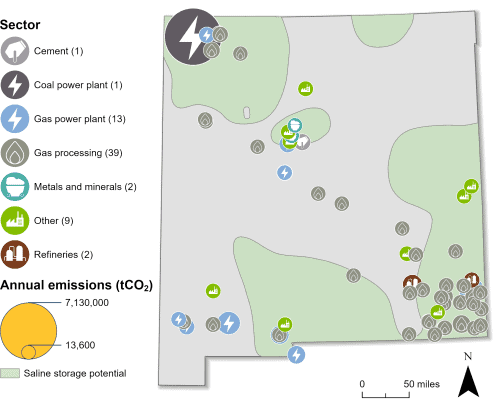New Mexico Carbon Capture Opportunities

Carbon management could play a key role in New Mexico’s emissions reduction efforts and clean energy goals. Of the 82 industrial and power facilities in the state, 67 are eligible for the 45Q federal tax credit. New Mexico’s power sector could see the most significant reductions, with 14 eligible facilities. In total, all 67 of the state’s 45Q-eligible facilities emit nearly 19 million metrics tons of carbon dioxide (CO2) annually, representing 99 percent of total annual CO2 emissions in the state.
Under Governor Michelle Lujan Grisham, New Mexico has prioritized emissions reduction and clean energy development. Carbon management is a critical component of this strategy, as the state is pursuing Class VI primacy and recently enacted important legislation to support carbon management deployment.

Industrial and Power Facilities in New Mexico
New Mexico has 82 industrial and power facilities, 67 of which are eligible for the 45Q federal tax credit. The state’s power sector, which includes gas and coal, accounts for over 70 percent of the state’s total annual CO2 emissions. All but one of New Mexico’s power plants are 45Q-eligible. In addition to the power sector, the state has 39 gas processing facilities, two refineries, one cement plant, and 11 other 45Q-eligible facilities. In total, these 67 facilities emit around 19 million metric tons of CO2 annually, representing 99 percent of New Mexico’s overall annual CO2 emissions.
Beyond capture, New Mexico has significant potential to store CO2 underground in geologic formations. As such, the state submitted a letter of intent to apply for funding under the US Environmental Protection Agency’s (EPA) Underground Injection Control (UIC) Class VI grant program in 2023. This grant program was developed to help states prepare for Class VI primacy, which gives individual states primary permitting authority over their Class VI injection wells. As of June 2025, New Mexico has one Class VI permit under review by the EPA. New Mexico is also well-positioned as a corridor for transporting CO2 regionally.

Sources: EPA GHGRP, 2024. Bauer et al., NATCARB, 2018.
Legislative Context for Carbon Management
In January 2019, Governor Michelle Lujan Grisham joined other states in the US Climate Alliance to commit to a reduction in greenhouse gas emissions by at least 26 to 28 percent below 2005 levels by 2025. This coalition of states agreed to track and report progress, accelerate new and existing policies to reduce carbon pollution, and promote clean energy deployment.
Since then, New Mexico has enacted important legislation more specifically addressing carbon management. In 2025, the state enacted HB 458, or the Carbon Dioxide Storage Stewardship Act. This bill addresses the key issue of long-term liability over CO2 storage wells and clarifies that liability will be transferred to the state upon issuance of a certificate of closure to a CO2 storage well operator. The legislation also creates a Geologic Carbon Dioxide Long-Term Storage Stewardship Fund, which will support the monitoring, remediation, enforcement, and emergency response for CO2 storage sites.
Several other pieces of carbon management related legislation were introduced in the 2025 legislative session, but did not pass before session adjourned in March. For more details on this legislation, see our State Legislative Tracker.
This bubble diagram shows the number of facilities and corresponding annual CO2 emissions for each industry in New Mexico. The darker bubbles are eligible for the 45Q carbon capture tax credit, while the faded bubbles are too small to be eligible. The total amount of CO2 emissions in New Mexico is listed for each industry in million metric tons.

Source: EPA GHGRP, 2024.
Last updated: June 2025

